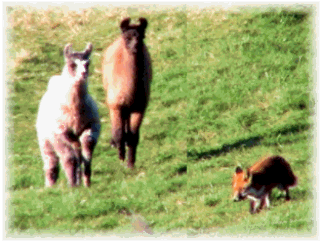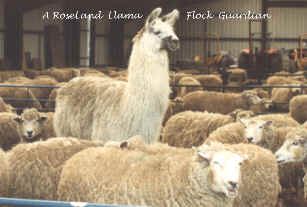|
"A male gelding llama
will guard livestock
sheep,
goats, free-range
poultry etc
by his own natural protective instinct..."

Two young llamas chase a fox
Two Iowa State University studies of
337 farms show llamas producing a stunning success rate as livestock protectors:
goat herds - 89% : poultry - 92% : sheep flocks - 93%
cattle herds - 100%

|

We
supplied our first guard llama to a farmer in Kent who had been losing 35-40 lambs
in previous
lambing seasons.
Subsequently, with our guard llama in place, he lost
none!
He liked his llama so much
that he returned to us to buy a female for him (happily, he was not yet castrated). Then
as a pair is likely to be less efficient than a single llama as a flock guardian, he
returned to buy yet another (this time gelded) male to become his flock
guardian!

RoseLand
Llamas
were
featured on UK National Television,
both on Channel 5 News and on Channel 4's "Absolutely Animals",
showing them at work guarding livestock.
Both
programmes recommended llamas
as the best option for keeping predators at bay. |

An
appropriately selected male gelding llama
will guard field stock
- sheep, goats, free-range poultry etc -
by his own natural protective instinct...
 | He needs no special training.
|
 | He requires no special fencing.
|
 | He can be expected to work effectively for around 10 - 12
years. |
 | He eats the same food as sheep or goats (but on a weight
basis, only about 2/3 as much). |
 | He can be left with the animals at all times without
extra attention
|
 | Despite his role as protector, he will live harmoniously
with farm dogs and other farm stock. |
 | He can be used to carry bales, implements etc...
|
 | He can be sheared alongside sheep, offering a quantity of
luxury fibre. |
 | He requires no extra or special veterinary attention.
|
 | He does not require dipping. |
 | He offers an extremely economic and practical solution
against predation losses.
|
Although a llama does not need
special training for his work as a flock guardian, it is all the
more important that the llama used for the work is carefully
selected.
Imagine any litter of puppies, be
they retrievers, sheep dogs, guard dogs, racing dogs, whatever. In
the litter, one may be too nervous, another too lazy, and another
too dim... too friendly... too aggressive! From each litter the
experienced breeder can usually work out which will be best suited
for the purpose of the breed or as show dogs, pets etc.
Equally with any group of llamas,
different temperaments and behavioural traits
will suggest to the experienced breeder which
are better suited as field pets, or fibre producers, trekkers or…
guard llamas! In this context it is important to note that the
appropriate attributes
of a guard llama do not include
aggressiveness (whether to people or other non-predatory animals).The
most successful guard llama should be a well socialised animal,
accepting of humans, farm livestock , children and pets...
|

|
Iowa State University
Research
Reports
Llamas have been used successfully for many years
in the USA to protect livestock from predators including wild dogs, foxes, coyotes and
even bears...
Extensive research at Iowa State University (Iowa has the largest concentration of sheep
farms in the US) confirmed the great value that llamas have in this area.
Two Studies have been undertaken
at the University.
The first was completed in 1997 and
the most recent was published in February 2000.
The conclusions of these studies are shown on the right. |
|
Llama Guarding
Questions…
|
"Why
will a llama guard my livestock?" |
It is the natural instinct of the
male llama to guard his "group". Experience and research have proved that when
removed from his own kind and placed with certain other types of livestock, the llama will
continue in this role. |
"How
will he guard my livestock?"
|
In the event of an animal worrying his flock, the
llama will lower his long neck and … charge at it, chasing it away. If it
lingers he will stamp his feet down aggressively at the attacker. He will not, however,
be "hell-bent" on killing it, only driving it away.
|
|
|
"But
won't he then chase my dogs or my children?" |
No: An appropriate guard llama is not
an aggressive llama or a mean animal. His temperament should be similar to that of a
"field pet" llama but have extra qualities that make him a suitable flock
guardian.
Generally llamas live very happily with dogs and any other animals that are introduced to
them properly.
Our own children play in our paddocks even where there are entire male and stud llamas
present. |
| "Can
I be sure it will work?" |
Unfortunately there is no absolute panacea and
there can be no concrete guarantees… Using a llama to protect livestock should
be considered as one measure among others. So far, however, we have experienced only 100%
success stories and the overall success rate in the U.S is circa 85%. |
|
|
"Will
any male llama do the job?" |
No! Although the llama does not need
training, it is very important that he is selected by an experienced person who
understands well the characteristics required for a guard llama. It is equally important
that the llama selected has been reared in the right manner, comes from a llama herd
environment, is put to work at the right age, and is gelded at the right time. |
| "How
do I go about choosing a guard llama?" |
Seek expert advice. Purchase your guard llama
from someone who fully understands the nature of llamas in general, the character of the
llama selected in particular, and the precise nature of the work of guard llamas.
Be sure you are not buying someone's unwanted
and inappropriate stock, or
retired stud male that is too old for the work
etc.
|
|
At
RoseLand Llamas
we offer a full advisory and selection service to maximise the likelihood of success
We will only offer you llamas that we believe should
prove suitable
for your purpose. |
More Questions about llamas?
Visit
Llama FAQs
To buy
llamas selected specially for livestock guarding please
contact us
|